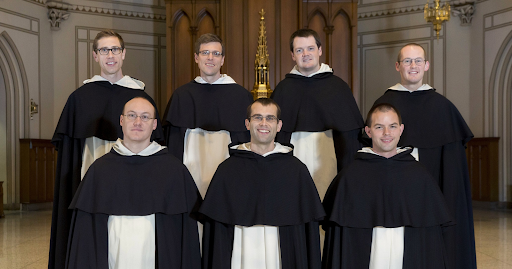Who Are the Dominicans?

Image Courtesy of the Dominican Friars Province of St. Joseph
By Zachary Lichter
The Dominican order will be taking over Catholic University’s Campus Ministry and celebrating mass on campus starting Fall 2022. The students and faculty of CUA have been used to the presence of the Franciscan friars for twenty-four years, but who exactly are the Dominicans? What will they bring to the campus community? Will Mass on campus somehow look different than it has been for twenty-four years?
The Dominican Order, also known as the Order of Preachers, was founded by St. Dominic de Guzman. Dominic was a Spanish priest that was struck for preaching the true faith to people while he was traveling to Southern France. When he began his public ministry, he established a group of women converts in a monastic community that would be given the extraordinary task of praying and preaching for Dominic and his companions. He gradually attracted men to join him in his mission of preaching and began to form the Order of Preachers. On December 22, 1216, Pope Honorius III approved the new order, and Dominic served as the Master of the Order until he died in 1221.
Since the Dominicans became an order, they were established to preach the Gospel for its intellectual tradition. They are known for their freedom of research, since the order has produced many theologians and philosophers. They are also known for coining the term Our Lady of the Most Holy Rosary. The Dominicans emphasize the significance and power of the rosary through their consistent prayer to Mary.
There were four popes from the Dominican order: Pope Innocent V, Pope Benedict XI, St. Pope Pius V, and Pope Benedict VIII. There have also been seven notable saints from the Dominican order starting of course with St. Dominic, St. Pius V, Albertus Magnus, St. Catherine of Siena, St. Raymond of Penafort, St. Rose of Lima, and Girolamo Savonarola.
One of the most notable Dominicans besides St. Dominic is St. Thomas Aquinas, known for his philosophical and theological writings. St. Thomas is specifically known for the Summa Theologiae, also known as the Summa Theologica, which is a book about Catholic theology. The CUA community celebrated his feast day on January 27th in the Basilica of the National Shrine of the Immaculate Conception.
With the Dominicans running Campus Ministry starting in the fall semester, they will likely incorporate their four active ideals of Dominican spirit and heritage within Campus Ministry. The first ideal is Study; St. Dominic believed that the Order should educate the world. The second ideal is Prayer; Dominicans have a love of the Gospel of Matthew because they believe in scriptural prayer. The Gospel of Matthew explains the Genealogy of Jesus Christ and has a lot of references to the Old Testament. The third ideal is Community, working for a better, more just, and more loving world. The pillar of Community serves to enable people to do whatever other people in the community can’t do by themselves. The final ideal is Service, which the world of ideas, life of the mind, and the spirit of the truth to God. With these four active ideals put into practice, the Dominicans will have the opportunity to use their vision within Campus Ministry.
The CUA community has always been used to the Franciscans’ mission of selfless love and humility for their neighbor in the Gospel. But as the Dominicans take over, they look to incorporate their research into their homilies. They will also look to influence Campus Ministry with their ideals. The CUA community is excited to see how mass will be different on campus and what ideas they will bring to Campus Ministry; they look forward to welcoming the Dominicans in the fall semester.






